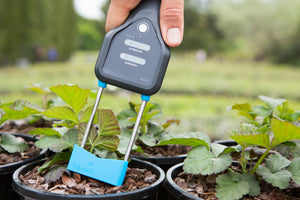Powdery mildew is a fungus that affects many types of plants. Both indoor and outdoor plants are susceptible to powdery mildew. This is one of the most common diseases that growers face. Consumption of plants subjected to powdery mildew infestations is hazardous to your garden’s health and should be avoided at all costs.
How to Identify Powdery Mildew
Powdery Mildew has the potential to annihilate a substantial crop, making early identification vital if you want to ward off this fuzzy menace. Powdery Mildew is one of the easier plant diseases to identify. Infected plants will display white powdery spots on the leaves and stems. The leaves will look as though they have been dusted with flour. The mildew can appear on any part of the plant that is above ground, although it tends to mostly affect the lower stems and leaves first. As the disease advances, the spots will get larger and denser, and eventually, the leaves will turn yellow, brown, and die.
Control and Prevention
Unfortunately, bringing back mature plants from this disease is very difficult. It is important as a gardener to be aware of powdery mildew and know how to manage the disease if you do come across it. Prevention is the first line of defense to controlling powdery mildew. High humidity promotes the growth of this disease, if you grow in a greenhouse environment be extra vigilant. You can reduce humidity by avoiding overhead watering, and selectively pruning overcrowded areas to increase airflow around your plants.
If you do come across powdery mildew, you do have a few options. First, remove and quarantine any infected plants at the first sight of any potential infection. Spreading powdery mildew to other plants is as simple as touching an infected plant and then touching one that is not. Spores can travel through the air rather easily allowing the mildew to quickly take over your entire operation.
You may be able to recover your plants by pruning any infected area. Once you have quarantined and pruned your infected plants, you may be able to salvage them using a foliar spray treatment.
Here at Way to Grow, we like to grow our crops as naturally and organically as possible. Below you will find a few organic foliar spray remedies that have worked for our team in the past. While these spray remedies are safe for your plants, they may negatively affect your soil. To avoid burning your plants or destroying the soil chemistry use a piece of cardboard to cover the soil when you apply any foliar spray treatment.
DIY Remedies
Baking Soda
- 1 Tbsp. baking soda
- 2-4 drops of organic biodegradable soap, such as Dr. Bronner’s
- 1-gallon distilled or RO water
- Apply to the affected area. Repeated applications will be necessary.
Organic Apple Cider Vinegar
- 2 tsp apple cider vinegar
- 1 quart distilled or RO water
- Apply to the affected area. Repeated treatments will be necessary.
Milk
- 1:10 ratio of 2% milk to distilled RO water
- Mix in a sterile spray bottle and apply to the infected area.
Over-the-Counter Remedies
Green Cure: One of the most popular products on the market. Spray plants once a week with a mixture of 2 tablespoons of Green Cure mixed with 1 gallon of distilled or Ro water for three weeks for best results.
Actinovate: An organic microorganism that combats diseases, blights, and mildews. Use as a foliar spray or a root drench. Apply 1 teaspoon Actinovate with 1 gallon of distilled or RO water to leaves once a week for two weeks or as a root drench once a week for two weeks.
Procidic 2 Organic: Procidic2 is a broad-spectrum fungicide/bactericide that is designed specifically for use on high-value plants.
- Preventative recipe: Mix 0.5-3.0 fl oz into 1 gallon of water (15-90 ml/gallon). Spray when favorable weather conditions are expected, or when disease inoculum is present. Spray every 5-10 days.
- Curative recipe: Mix 1-3.5 fl oz into 1 gallon of water (25-100 ml/gallon). Upon discovery of the disease, spray every 3-5 days. Repeat until control is attained.
The More You Know, The Better You Grow
Most remedies require multiple applications to be most effective. Moisture will wash foliar sprays off, even morning dew on plants has the potential to remove the coating off of the leaves. The best time to apply foliar spray treatments is before noon on a dry sunny day for outdoor plants. For indoor plants controlling humidity is key. A strong prevention game is your best bet to battling Powdery Mildew, but if your crop does succumb all hope is not lost.
